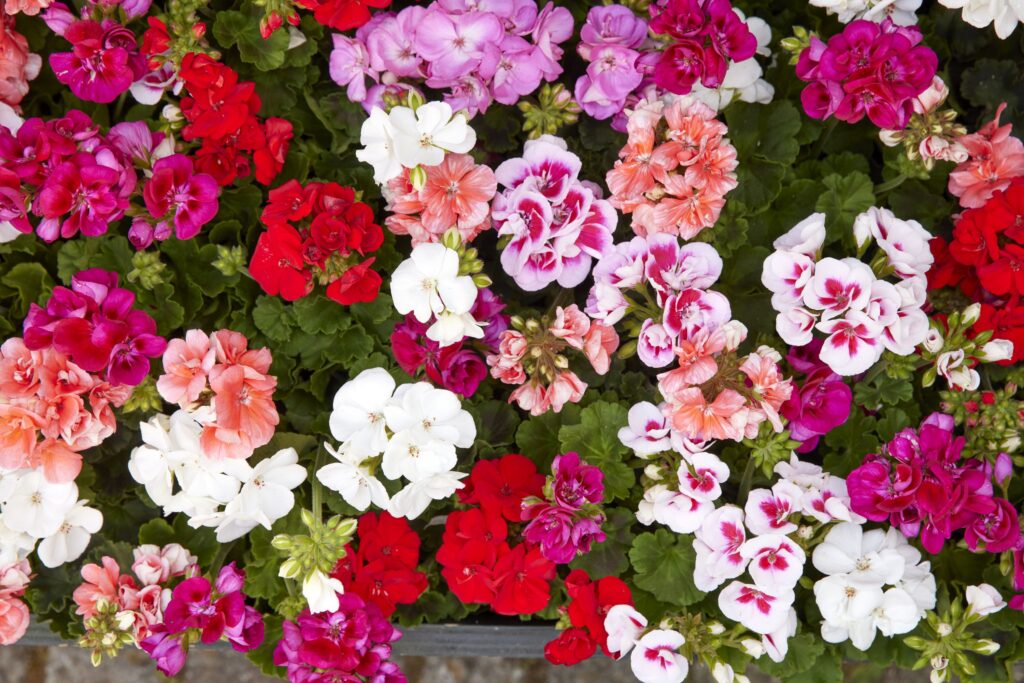In most European countries geraniums are the top-ranking bedding and balcony plant for spring / summer – and with good reason. These eye-catching beauties offer a very wide range of colours and shapes in their flowers and foliage and they are extremely floriferous, producing abundant blooms for months on end, from spring to autumn. Geraniums and Pelargoniums are also famously robust and easy to care for, being unfussy, tolerant of high summer heat and unsusceptible to pests and diseases, but there are a few simple measures you can take to keep them in tip top condition and looking their very best. Here, the experts at Pelargonium for Europe explain how to keep the geraniums in your garden containers and conservatory looking their very best.
Getting started
Don’t buy geraniums too early. They should only be planted outdoors when there is no longer a threat of frost at night and temperatures reach double[1]digit degrees during the day. Chose good quality geraniums, which you can recognise by a bushy growth, strong shoots, plenty of buds and a well-rooted root ball.
Location
Geraniums are sun-worshippers and prefer a full sun location, but they can also cope with partial shade. The more sunlight they get, the more abundant they will bloom. Varieties with large or double flowers appreciate a spot protected from strong winds and rain, for example, against the wall or under a roof. The Regal geranium was originally cultivated as a houseplant and will feel at home in a sunny spot indoors, especially a warm, bright conservatory or greenhouse. This also works for angel and scented-leaved geraniums. The classic outdoor geranium types might also survive indoors but in spring/summer they thrive best outdoors. Use high quality compost.
Geraniums need a lot of space, so leave a distance of 20cm between individual plants and use pots that are big enough. A pot for a single plant should have a minimum diameter of 20cm and a height of 18cm. A layer of clay shards, expanded clay pebbles or similar materials on the bottom of the planter ensures drainage.
Watering
Whilst these South African native plants are more drought tolerant than most, even in hot, full sun, geranium soil should always be kept moist if you want them to keep producing new flowers. On very hot days you may need to water them every day, or even both morning and evening, especially if they are in containers. Even on rainy days watering might be necessary, especialy with bushy plants, where light raindrops don’t always reach the soil.As a general rule, they need water whenever the soil feels warm and dry. Beware of over-watering, however, as geraniums do not tolerate waterlogging and need good drainage. Balcony boxes with reservoirs or a homemade watering irrigation system can reduce watering time considerably and help keep plants in good condition when you go on holiday.
Fertilising
Like all densely flowering beauties, geraniums are ‘hungry’ plants that need a lot of nutrients. For an ideal supply of nutrients for geraniums, just mix a commercially available liquid fertiliser for flowering plants into the water once a week. If you’re using pre-fertilised potting compost, you should re-fertilise after four to six weeks. Alternatively, fertiliser sticks can supply the plants for two to three months. A slow-release fertiliser will even provide enough nutrients for up to nine months and you can add it to the soil later if you didn’t do so when you first planted the plants.
Dead heading
To make geraniums look more attractive and stay healthier, faded flowers and wilted leaves should be removed regularly. Deadheading stimulates the plants to form new flowers instead of putting their energy into the formation of seeds. Self-cleaning varieties will shed their faded flowers automatically making them bloom more readily. However, you will still need to remove withered leaves from these geraniums manually.

